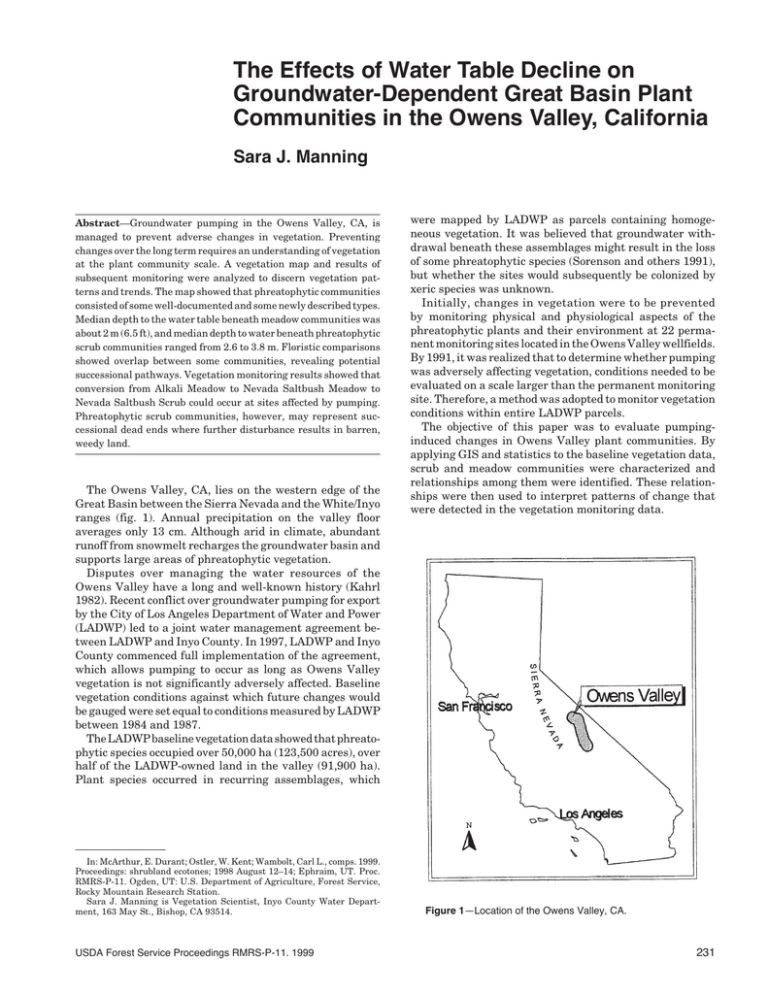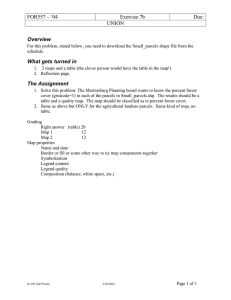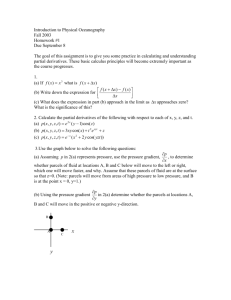The Effects of Water Table Decline on Groundwater-Dependent Great Basin Plant
advertisement

The Effects of Water Table Decline on Groundwater-Dependent Great Basin Plant Communities in the Owens Valley, California Sara J. Manning Abstract—Groundwater pumping in the Owens Valley, CA, is managed to prevent adverse changes in vegetation. Preventing changes over the long term requires an understanding of vegetation at the plant community scale. A vegetation map and results of subsequent monitoring were analyzed to discern vegetation patterns and trends. The map showed that phreatophytic communities consisted of some well-documented and some newly described types. Median depth to the water table beneath meadow communities was about 2 m (6.5 ft), and median depth to water beneath phreatophytic scrub communities ranged from 2.6 to 3.8 m. Floristic comparisons showed overlap between some communities, revealing potential successional pathways. Vegetation monitoring results showed that conversion from Alkali Meadow to Nevada Saltbush Meadow to Nevada Saltbush Scrub could occur at sites affected by pumping. Phreatophytic scrub communities, however, may represent successional dead ends where further disturbance results in barren, weedy land. The Owens Valley, CA, lies on the western edge of the Great Basin between the Sierra Nevada and the White/Inyo ranges (fig. 1). Annual precipitation on the valley floor averages only 13 cm. Although arid in climate, abundant runoff from snowmelt recharges the groundwater basin and supports large areas of phreatophytic vegetation. Disputes over managing the water resources of the Owens Valley have a long and well-known history (Kahrl 1982). Recent conflict over groundwater pumping for export by the City of Los Angeles Department of Water and Power (LADWP) led to a joint water management agreement between LADWP and Inyo County. In 1997, LADWP and Inyo County commenced full implementation of the agreement, which allows pumping to occur as long as Owens Valley vegetation is not significantly adversely affected. Baseline vegetation conditions against which future changes would be gauged were set equal to conditions measured by LADWP between 1984 and 1987. The LADWP baseline vegetation data showed that phreatophytic species occupied over 50,000 ha (123,500 acres), over half of the LADWP-owned land in the valley (91,900 ha). Plant species occurred in recurring assemblages, which In: McArthur, E. Durant; Ostler, W. Kent; Wambolt, Carl L., comps. 1999. Proceedings: shrubland ecotones; 1998 August 12–14; Ephraim, UT. Proc. RMRS-P-11. Ogden, UT: U.S. Department of Agriculture, Forest Service, Rocky Mountain Research Station. Sara J. Manning is Vegetation Scientist, Inyo County Water Department, 163 May St., Bishop, CA 93514. USDA Forest Service Proceedings RMRS-P-11. 1999 were mapped by LADWP as parcels containing homogeneous vegetation. It was believed that groundwater withdrawal beneath these assemblages might result in the loss of some phreatophytic species (Sorenson and others 1991), but whether the sites would subsequently be colonized by xeric species was unknown. Initially, changes in vegetation were to be prevented by monitoring physical and physiological aspects of the phreatophytic plants and their environment at 22 permanent monitoring sites located in the Owens Valley wellfields. By 1991, it was realized that to determine whether pumping was adversely affecting vegetation, conditions needed to be evaluated on a scale larger than the permanent monitoring site. Therefore, a method was adopted to monitor vegetation conditions within entire LADWP parcels. The objective of this paper was to evaluate pumpinginduced changes in Owens Valley plant communities. By applying GIS and statistics to the baseline vegetation data, scrub and meadow communities were characterized and relationships among them were identified. These relationships were then used to interpret patterns of change that were detected in the vegetation monitoring data. Figure 1—Location of the Owens Valley, CA. 231 Methods _______________________ Vegetation Classification During the LADWP 1984-1987 vegetation survey, the dominant species occurring in the parcels were used to assign the parcels to a California Department of Fish and Game “Holland (1986)” plant community. Recently, I analyzed these assignments for the scrub and meadow communities (Manning 1997) to: determine the quantitative characteristics of the plant communities; identify potential anomalies and outlier parcels; compare Owens Valley plant communities to those reported in the literature; begin to update the classification and align it with the currently accepted statewide vegetation classification system (Sawyer and Keeler-Wolf 1995); and analyze the parcel cover and species composition using multivariate techniques. All LADWP parcel data were screened to remove errors and redundancies. Percent cover of each species in each parcel was computed and used for all further analyses. Diversity indices were calculated using eH' (Hill’s N1) and 1/lambda (Hill’s N2), where H' is Shannon’s index and lambda is Simpson’s index. Both indices emphasize dominant species, and, in effect, N1 is the number of abundant species and N2 is the number of very abundant species in the community (Ludwig and Reynolds 1988). Depth to water table (DTW) data were obtained from the time of the baseline vegetation survey from observation wells located throughout the Owens Valley. These data were kriged to develop a GIS-based grid coverage for DTW (C. Howard, Inyo County Water Dept. report, in preparation). Mean and median DTW, obtained by tallying the grid cells underlying each parcel, were summarized by plant community. Non-metric multidimensional scaling (MDS) (NTSYS-pc) using species cover data was applied to explore the relationships among parcels within a community and to look for overlap between communities. The latter was achieved by running all parcels in each possible pair; for example, all rabbitbrush scrub parcels with all Nevada saltbush scrub parcels. Community “centroids” (single data entries per community containing the mean cover for each species in each parcel) were also compared to derive the relationships among all communities. A Bray-Curtis distance matrix served as the input for MDS. Output was arrayed along three axes, and groupings, outliers, and possible gradients were identified visually using the degree to which parcels intermingled in the output data (Manning 1997). Effects of Groundwater Pumping From 1991-1997, a set of parcels was annually inventoried to monitor the vegetation response to lowered water table. Of the approximately 95 parcels in the set, about one-half lay within areas of groundwater withdrawal (wellfield areas) and half served as controls. All 95 parcels were inventoried in 1992 and 1996; in other years, a subset was inventoried. From 1987-1994, pumping had lowered the water table beneath all wellfield parcels. In 1995, some of the parcels experienced recovery of the water table due to groundwater recharge and curtailment of pumping. This trend continued through 1997, by which time water tables had recovered in about one-third of the wellfield parcels. The water table 232 beneath control parcels had been affected solely by natural fluctuations in discharge and recharge. Drought conditions prevailed in the Owens Valley from 1987-1992, and 1994 was also a dry year. Because it had been used originally to inventory the vegetation, the line-point transect technique was employed to monitor changes in plant cover and composition. Each year, 12 to 30 50-m transects were randomly located within the selected parcels, and the identity of live plants was recorded at 0.5-m intervals along the transect. Data were analyzed to assess changes in perennial cover. In addition, annual changes in species composition were analyzed according to plant life form. The three life form categories used for analysis included all the common species, and they are defined as: Grass—perennial, native grasses, primarily saltgrass (Distichlis spicata) and alkali sacaton (Sporobolus airoides). Shrub—native shrubs, primarily Nevada saltbush (Atriplex lentiformis ssp. torreyi), rabbitbrush (Chrysothamnus nauseosus), greasewood (Sarcobatus vermiculatus) and other native woody perennials. Weed—annual and/or exotic species, primarily fivehook bassia (Bassia hyssopifolia) and Russian thistle (Salsola tragus). The data were searched for trends within communities to see whether or how they differed from overall trends. The Wilcoxon signed-rank test (SYSTAT 5.0) was used to determine significant changes (p <0.05). Because management according to plant community had not been envisioned when monitoring began, there were not always sufficient numbers of parcels within each community to demonstrate statistically significant trends. In instances where less than two parcels defined the group, data were omitted from these analyses. Results and Discussion __________ Vegetation Classification Scrub and meadow plant communities identified by LADWP during the 1984-1987 survey and pertinent quantitative characteristics are listed in table 1. The predominant plant community in the Owens Valley was Alkali Meadow. Great Basin Mixed Scrub, Greasewood Scrub, and Desert Sink Scrub, and Shadscale Scrub also covered large portions of LADWP land. Median DTW for the plant communities ranged from 1.6 to 8.5 m (no data were available for areas under Blackbrush Scrub). Previous studies had determined that the maximum rooting depth of the two dominant grasses in the Owens Valley, saltgrass and alkali sacaton, was 2 m; for the dominant shrubs, Nevada saltbush, rabbitbrush, and greasewood, it was 4 m (Groeneveld 1990). Correspondingly, the GIS grid of 1984-1987 DTW beneath the plant communities showed meadow communities with median DTW near 2 m and phreatophytic scrub communities with DTW from 2.6 to 3.8 m (table 1). Shadscale scrub, which is not believed to be a phreatophytic community (Billings 1949), had a DTW of 2.7 m. Median DTW in all other xeric communities exceeded 4 m. Therefore, the communities most likely to be USDA Forest Service Proceedings RMRS-P-11. 1999 Table 1—Characteristics of Owens Valley plant communities. Phreatophytic communities are denoted with an asterisk. Plant community Median DTW Average cover Mapped area No. species Diversity index Shrub Blackbrush Scrub Mojave Mixed Woody Scrub Great Basin Mixed Scrub Big Sagebrush Scrub Desert Saltbush Scrub Rabbitbrush Scrub* Nevada Saltbush Scrub* Shadscale Scrub Greasewood Scrub* Desert Sink Scrub* m percent ha N1 N2 n.d. 8.5 5.0 6.8 4.4 3.8 2.8 2.7 2.6 1.9 15.7 19.6 15.6 17.9 13.7 14.8 20.1 12.7 13.0 14.2 1,604 3,694 11,193 4,320 1,362 3,917 3,305 8,425 10,482 9,655 16 28 56 40 21 33 22 33 27 30 3.8 10.5 20.1 5.7 4.4 7.0 5.3 6.1 6.3 8.4 2.3 6.3 13.3 2.4 2.6 3.3 2.8 2.7 3.8 6.1 Meadow Alkali Meadow* Rabbitbrush Meadow* Nevada Saltbush Meadow* Rush/Sedge Meadow* 1.6 2.2 1.9 2.0 37.8 31.0 31.5 69.4 18,140 748 1,323 1,509 78 20 17 55 7.9 5.3 4.5 18.2 4.3 3.4 3.3 10.9 adversely affected by groundwater pumping were: Alkali Meadow, Desert Sink Scrub, Rabbitbrush Meadow, Nevada Saltbush Meadow, Rush/Sedge Meadow, Greasewood Scrub, Nevada Saltbush Scrub, and Rabbitbrush Scrub. These are marked with an asterisk in table 1. Depth to water was not observed to be correlated with patterns of cover or species diversity among the phreatophytic communities. Average plant cover in these communities ranged from 13.0 percent for Greasewood Scrub to 69.4 percent for Rush/Sedge Meadow. (Rush/Sedge Meadow is often irrigated in the Owens Valley.) The number of species recorded in the phreatophytic communities ranged from 17 for Nevada Saltbush Scrub to 78 for Alkali Meadow. Rush/Sedge Meadow exhibited the highest diversity indices, Desert Sink Scrub had the second highest, and Nevada Saltbush Meadow and Nevada Saltbush Scrub retained the lowest diversity indices. Descriptions for most but not all Owens Valley communities matched those of Holland (1986). Nevada Saltbush Scrub, Nevada Saltbush Meadow, and Rabbitbrush Meadow were newly described, and others (Sawyer and Keeler-Wolf 1995; Bourgeron and Engelking 1994) do not describe series or associations that matched these three communities. The prevalence of the two Nevada saltbush-dominated communities in or near wellfields suggested that lowered water tables may have influenced their development. Owens Valley Desert Sink Scrub possessed the same name as a previously described community (Holland 1986), but the written description differed. In the Owens Valley, this community displayed high diversity with as many as five species serving as co-dominants. Also, despite being designated “scrub” the parcels possessed a high proportion of grasses, and median DTW was 1.9 m. MDS output for community centroids appears in figure 2. Although MDS processed data on parcel floristic composition only, the three-dimensional display suggests environmental gradients along which the communities may be aligned. For example, Shadscale Scrub, Greasewood Scrub, USDA Forest Service Proceedings RMRS-P-11. 1999 Desert Sink Scrub, Alkali Meadow, and Rush/Sedge Meadow are arrayed in increasing order along the x-axis, are nearly constant along the y-axis, and increase along the z-axis. Rabbitbrush Scrub and Nevada Saltbush Scrub are lower along the y-axis than their meadow counterparts. The pairwise MDS outputs (not presented) revealed floristic overlap between some plant communities. By combining the MDS output for community centroids (x- and y-axes only) with the pairwise results, a simple model showing relationships among Owens Valley plant communities was constructed (fig. 3). Figure 3 depicts the communities with circles proportional to the number of parcels used for these analyses. Two major groups were distinguished: xeric and phreatophytic, with the division occurring between Shadscale and Greasewood Scrubs. Figure 2—Three-dimensional MDS output for plant community centroids. 233 Figure 3—Diagrammatic model showing floristic overlap between Owens Valley communities. It was hypothesized that succession could occur between communities adjacent to each other in figure 3. For example, alkali sacaton-dominated Alkali Meadow might convert to Desert Sink Scrub or Nevada Saltbush Meadow. Nevada Saltbush Meadow may tend toward Nevada Saltbush Scrub. exceed baseline in subsequent years. For wellfield Alkali Meadows, cover declined and remained below baseline levels in all years (fig. 6a). Increased cover in the control Alkali Meadows was largely due to increases in the shrub rabbitbrush, and declines in wellfield Alkali Meadows were due to declines in grass cover (fig. 7a). Recovered Alkali Effects of Groundwater Pumping Groundwater pumping from 1987-1992 caused measurable declines in the water table beneath wellfields and was correlated with adverse vegetation changes (Manning 1998). On average, parcels within the wellfields declined in perennial cover, while control parcels increased (fig. 4). In 1995, the “recovered wellfield” group was created to account for the wellfield parcels located in areas where water tables began returning to the plant root zones. From baseline years to 1997, changes in plant life form occurred. Generally, grasses declined in wellfields, and shrubs and weeds increased everywhere (fig. 5). For the three management categories, annual changes in total perennial cover and 1997 changes in life form are discussed below by community. Figures 6a-e show annual average changes in perennial cover that occurred in five phreatophytic communities from 1991-1997. Figures 7a-e show average changes in plant life forms from baseline to 1997. In control Alkali Meadows, perennial cover had increased significantly above baseline levels by 1993 and continued to 234 Figure 4—Annual average change from baseline in perennial cover for control, wellfield, and recovered wellfield parcels. Asterisks denote significant change from baseline (p <0.05). USDA Forest Service Proceedings RMRS-P-11. 1999 Figure 5—Average change in grass, shrub, and weed cover between baseline year and 1997, in control, wellfield, and recovered wellfield parcels. Asterisks denote significant change from baseline (p <0.05). Meadows showed no statistically significant change in total perennial cover from baseline (fig. 6a, 1995 through 1997), but shrub cover, primarily Nevada saltbush, increased (fig. 7a). Control Nevada Saltbush and Rabbitbrush Meadows (fig. 6b, c, respectively) did not show measurable changes in perennial cover from baseline conditions. Wellfield parcels for both communities, however, showed declines relative to baseline, but with one exception, these were not statistically significant. Declines in wellfield perennial cover for these two communities was, apparently, caused by declines in grass and shrub cover (fig. 7b, c). Results in figures 6b and 7b suggest that Nevada Saltbush Meadows react to pumping-induced decline and recovery of the water table by first dying back, then rapidly increasing in Nevada saltbush growth. Results of shrub recruitment monitoring further support this hypothesis (S. Manning, Inyo County Water Dept., data on file). The continuation of this trend could result in conversion of this community from Meadow to Nevada Saltbush Scrub. From 1995-1997, control Nevada Saltbush Scrub parcels showed slight increases in perennial cover due to increases in grass cover (fig. 6d and 7d). This finding and field observations of senescent alkali sacaton tufts beneath shrubs suggest that these sites were meadows in the past. Wellfield and recovered wellfield Nevada Saltbush Scrub parcels, however, showed decreases in shrub cover, suggesting that pumped Nevada Saltbush Scrub cannot sustain itself. Although the apparent decline in perennial cover relative to baseline in the recovered wellfields (fig. 6d, 1996-1997) may represent a longer lag time between water table recovery and vegetation response, the poor performance of the control parcels and the observed accumulations of dead, woody debris at these sites suggest that pumped Nevada Saltbush Scrub may eventually degenerate beyond the ability to fully recover with native vegetation. USDA Forest Service Proceedings RMRS-P-11. 1999 Figure 6—Annual average change from baseline in perennial cover for control, wellfield, and recovered wellfield parcels grouped according to plant community: (a) Alkali Meadow; (b) Nevada Saltbush Meadow; (c) Rabbitbrush Meadow; (d) Nevada Saltbush Scrub; (e) Rabbitbrush Scrub. 235 Very few Rabbitbrush Scrub parcels have been systematically inventoried. From baseline years to 1997, control Rabbitbrush Scrub parcels have increased in shrubs, while recovered wellfield parcels have increased in shrubs and weeds (fig. 6e and 7e). Conclusions ____________________ Vegetation parcels mapped by LADWP in the 1980’s generally sorted into distinct communities possessing diagnostic characteristics. MDS revealed overlap between certain communities, suggesting potential directions for community conversion. Monitoring data from 1991-1997 showed that when affected by groundwater pumping Alkali Meadow may succeed to either Nevada Saltbush Meadow or Rabbitbrush Meadow, but not Desert Sink Scrub. The conversion to Nevada Saltbush Meadow may occur relatively quickly when water tables are altered due to pumping. Conversion to Rabbitbrush Meadow could be affected by pumping, grazing, and/or other disturbances. Currently, these are allowable changes under the water agreement, but improved understanding of this trend may render this change undesirable. The species-poor Nevada Saltbush Scrub and Rabbitbrush Scrub communities appear to result from intense disturbance. The former was shown to be adversely affected by groundwater pumping. Both communities may be the last vestiges of native plant communities; if disturbance continues they may degenerate into barren sites populated in wet years by annual weeds. Approaching pumping-induced vegetation changes from the plant community perspective shows promise that trends can be correlated with community change. Further understanding of the characteristics of and the processes sustaining the plant communities will allow better management, because adverse changes may be identified sooner and communities with no known successional endpoint may be managed more conservatively. Acknowledgments ______________ D. Waterbury, D. Olson, B. Stange, R. Potashin, S. Frei, A. Parravano, S. Osotoja, and others assisted extensively with field data collection. C. Howard, Inyo County GIS Specialist, helped with DTW information and figure 1. References _____________________ Figure 7—Average change in grass, shrub, and weed cover between baseline year and 1997, in control, wellfield, and recovered wellfield parcels grouped according to plant community as in figure 6. 236 Billings, W. D. 1949. The shadscale vegetation zone of Nevada and eastern California in relation to climate and soils. American Midland Naturalist. 42(1): 87-109. Bourgeron, Patrick S.; Engelking, Lisa D., eds. 1994. A preliminary vegetation classification of the Western United States. Boulder, CO: Western Heritage Task Force for the Nature Conservancy. Groeneveld, David P. 1990. Shrub rooting and water acquisition on threatened shallow groundwater habitats in the Owens Valley, California. In: McArthur, E. Durant; Romney, Evan M.; Smith, Stanley D.; Tueller, Paul T., comps. Proceedings: symposium on cheatgrass invasion, shrub die-off, and other aspects of shrub USDA Forest Service Proceedings RMRS-P-11. 1999 biology and management; 1989 April 5-7; Las Vegas, NV. Gen. Tech. Rep. INT-276. Ogden, UT: U.S. Department of Agriculture, Forest Service, Intermountain Research Station: 221-237. Holland, Robert F. 1986. Preliminary descriptions of the terrestrial natural communities of California. Sacramento: California Department of Fish and Game. 156 p. Kahrl, William L. 1982. Water and power. Los Angeles: University of California. 583 p. Ludwig, John A.; Reynolds, James F. 1988. Statistical ecology. New York: John Wiley. 337 p. USDA Forest Service Proceedings RMRS-P-11. 1999 Manning, Sara J. 1997. Plant communities of LADWP land in the Owens Valley: an exploratory analysis of baseline conditions. Bishop, CA: Inyo County Water Department. 160 p. Manning, S. 1998. Results of 1997 vegetation re-inventory. Bishop, CA: Inyo County Water Department. 26 p. Sawyer, John O.; Keeler-Wolf, Todd. 1995. A manual of California vegetation. Sacramento: California Native Plant Society. 471 p. Sorenson, Stephen K.; Dileanis, Peter D.; Branson, Farrel A. 1991. Soil water and vegetation responses to precipitation and changes in depth to ground water in Owens Valley, California. U.S. Geological Supply Paper 2370-G. 54 p. 237





